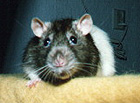



Epidemiological Features of Hantaviruses Infection
C. Epidemiological_Features
This newly defined group of viruses have been reported within many species of rodents and man worldwide. The HVDs reported in different parts of the world have now been confirmed as being caused by an antigenically-related group of viruses. These agents also share similarities in their epidemiological and ecological characteristics. Adult rodents show persistent infection without any clinical manifestations and secrete virus for prolonged periods. Following inoculation, a viraemia develops in the rodent during which, the virus is disseminated throughout the body. The virus is found in the lungs, spleen and kidneys for long periods in the rodent, perhaps for life. Saliva appears to play an important role in the horizontal transmission of the virus between rodents.
Man is probably infected through the respiratory route via aerosols of virus particles excreted by rodents in their lungs, saliva, urine and faeces. Transmission had also been documented following bites by rodents. Horizontal transmission among humans has not been documented, although blood and urine are infectious during th first 5 days of illness. Nosocomial spread was not documented during the Korean War. Although hantaviruses have been reported to have been recovered from some species of mites. It is generally accepted that arthropods are not necessary for transmission of the viruses between rodents and from rodents to man. Many hantavirus isolates have been isolated from humans and rodent hosts and are typed according to their serological cross- reactivity. There are at least 14 subtypes. The following are some of the subtypes associated with human disease.
 |
 |
 |
 |
Rodent carriers of hantviruses: left to right - stripped field mouse, rat, bank vole, and deer mouse
D. Laboratory Diagnosis
The diagnosis of HVD is usually made on the clinical findings and serology results. In the early phase of the illness, the infection cannot be differentiated from other virus fevers. History should be sought for any possible contact with rodents.
E. Treatment and Prevention
Attentive and supportive therapy is important during the first
3 phases of the illness. Trials with ribavirin suggested a
reduction in mortality if the treatment is started within the
first 5 days of illness. A trial with a
-interferon was not successful. HVD is mainly a disease of
poverty and war. Control should be directed at reducing the
contact between rodent populations and humans. An inactivated
cell culture vaccine had been prepared in China where clinical
trials are due to begin soon. A portion of the Hantaan virus
genome has been cloned into vaccinia.
F. Comparative Clinical Features of Recognized
Hantavirus Disease_HVD
Nephropathia Far
Eastern
Rat-bourne Balkan
Epidermica
HVD
HVD
HVD
Virus type Puumala Hantaan Seoul Porogia
Overall Severity ..... 1-2 2-4 1-3 2-4
Multiphasic Disease occasionally Yes Blurred Yes
Hepatic abnormalities 0 0-1 1-3 0-1
Haemorrhagic phenomenon 0-1 1-4 1-2 1-4
Mortality <1% 5-10% 1% 5-35%
Score = 0 to 4
G. Hantavirus Pulmonary Syndrome
A unique hantavirus has been identified as the cause of the outbreak of respiratory illness (hantavirus pulmonary syndrome) first recognized in the "Four Corners" region SW USA in 1993. The rodent reservoir is the deer mouse. Onset of the illness is characterized by a prodrome consisting of fever, myalgia and variable respiratory symptoms eg. cough followed by the abrupt onset of acute respiratory distress. Headache and GI complaints have also been documented. Overall, the mortality rate had been 62%. The pathology is essentially the same as for the classical hantaviruses whereby damage to the capilliries and blood leakage occurs. In this case, the lungs rather than the kidneys are predominantly affected. Diagnosis is usually made by the demonstration of IgM by serological tests. RT-PCR and immunehistochemistry had also been reported to be useful. Virus isolation is not an option since the virus has never been isolated from clinical specimens.Ribavirin is being currently assessed in the treatment of hantavirus pulmonary syndrome. The virus involved is most closely related to the Prospect Hill virus and is called Sin Nombre virus. Deer mouse is distributed in most parts of the U.S., parts of Canada and Mexico. The risk to campers and hikers from hantaviruses is very small, the CDC have published guidelines for reducing the risk of exposure to rodents. Hantaviruses found in other rodents such as the white-footed mouse, the cotton rat and the rice rat have also been associated with hantavirus pulmonary syndrome. At present, at least three hantaviruses are associated with the syndrome.
Link to CDC's slide set on "Hantavirus Pulmonary Syndrome and Sin Nombre Virus"